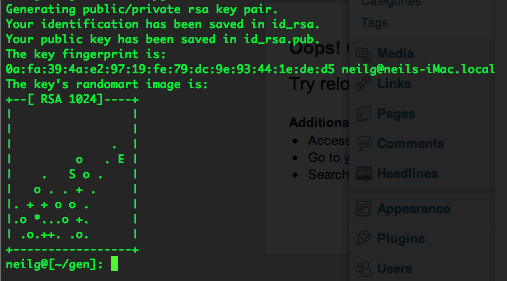Get Generated Ssh Key Ion Mac Os
First cool thing that everybody knows already: Mac OSX is based on Unix so you get ssh out of the box.
Second cool thing you may not know: OS X 10.5 actually also comes with an ssh key agent (ssh-agent). That means that, without any additional software (like PuTTY Agent on Windows...), Mac OSX can actually load an encrypted private key into memory and remember it for all subsequent connections...
To generate SSH keys in Mac OS X, follow these steps: Enter the following command in the Terminal window: ssh-keygen -t rsa -b 4096. This starts the key generation process. When you execute this command, the ssh-keygen utility prompts you to indicate where to store the key. DynaFabric is an SSH based command dispatching and systems management framework, designed for easy implementation on existing networks. It allows you to configure SSH key based authentication, and centrally dispatch commands, manage installed software, maintain services,.

Third cool thing that almost seems too good to be true: ssh-agent can store the passwords of the encrypted keys into your keychain. Than means that you have to tell it once to remember the decryption password for your key(s) like this:
Get Generated Ssh Key In Mac Os Free
ssh-add -K .ssh/id_whatever_your_rivate_key_is
And next time you log into your mac and try to ssh somewhere, your private key will be loaded automagically (as long as your keychain is unlocked of course).
Mac Ssh Key
Very groovy!!
This guide will show you how to enable SSH (remote login) on your Mac OS X machine and connect to it using a private key file (.ppk) while disabling password logins (more secure). In this example, we will setup the remote connection using Putty.
- Enable SSH on your Mac. Go to System Preferences -> Sharing -> Remote Login.
- Now, we will generate our private and public SSH keys on our Mac. Open Terminal and type the following commands.
Mac Os Copy Ssh Public Key
Create a .ssh directory. This directory will be hidden in your Mac X User home path.
Generate SSH private and public keys.
- Now, we want to create an authorized_keys file in the same directory to allow remote hosts to connect to our Mac using the key file we just generated.
Create the authorized_keys file in Terminal.
- Let’s take a look at the keys and authorized keys files we just created. At the menu bar, select Go -> Go to Folder… and type /Users/USER/.ssh replacing USER with your Mac X username. We see 3 files.
authorized_keys - your shared public key file
id_rsa - your private key
id_rsa.pub - your public key
- We want to copy our Public Key exactly into our authorized_keys file. Open id_rsa.pub and copy the text into your authorized_keys file. Save the file. (To do this, you can drag both files to your Desktop to gain access to perform the copies if needed, then drag back to the .ssh folder). See example below.
- In order to use Putty to connect via SSH via a private key, we must convert the id_rsa private key to Putty format (.ppk). We will use PuttyGen.exe to convert our id_rsa private key to a .ppk file. Download and install PuttyGen here.
Note:You can run PuttyGen.exe on Mac OS X following this guide. Otherwise, you will need to run PuttyGen on a Windows machine.
- Launch PuttyGen.exe and click Load.

- For Files of Type select All Files. Locate and select your id_rsa private key.
- Click Save private key. Click Yes to save without a password (this is not needed). You can name the file whatever you want.
You now have a .ppk file we can use for our Putty connection. Save this key somewhere safe and never share it with anyone!
Next, we will configure SSH on our Mac to only allow key authentications and disable password authentications. This will immediately drop a connection made to our Mac unless a key file is being used (more secure).
Configure SSH on Mac OS X to Force Private Key Authentication Only
- At the menu bar, select Go -> Go to Folder… and type /etc/ssh/ and hit return.
- Open the sshd_config file. (To edit this, file you can drag it to your Desktop to edit then drag back to same folder)
- We need to change 2 lines in sshd_config file.
Change UsePAM no
Uncomment and change PasswordAuthentication no
- Save the ssh_config file.
- Restart Mac X remote login for our changes to take affect. Go to System Preferences -> Sharing -> Remote Login and turn off / on.
Now, we can use Putty to create an SSH connection to our Mac we generated our keys on. Download and install Putty here.
Note:You can run Putty.exe on Mac OS X following this guide.
Open Putty and create a new connection. We will point to our private key file (.ppk). Go to Connection -> SSH -> Auth and load the .ppk file here. This can be tricky, ensure your creating a new connection in Putty and saving it so it remembers the key we just imported.
Try connecting. You will receive a login prompt for username. This will be the user of your Mac (any other username you put here will fail immediately).
If successful, you will login to your shell immediately pictured below! No password needed!
Generate Ssh Key On Mac
Please use the comment form to report dead links.